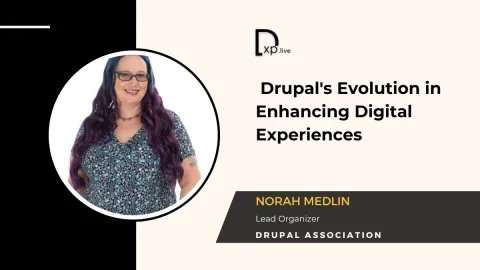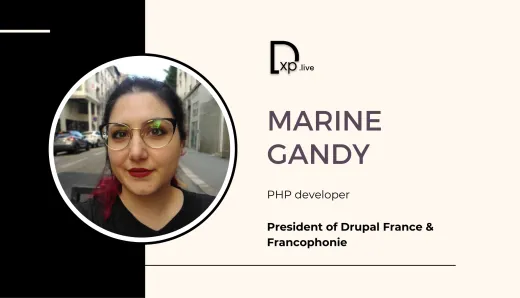Transforming Drupal: Norah on Project Browser and the Starshot Initiative
Drupal's Evolution in Simplifying Site Building and Enhancing Digital Experiences

Norah is currently serving as the lead organizer at MidCamp, a Drupal community event. This is her first term in a two-year leadership position, but she has been volunteering with MidCamp for the past couple of years. As the lead organizer, Norah coordinates all the other organizers and oversees the planning of their annual event, which is coming up next May.
Her involvement with MidCamp has been a great way for Norah to contribute to the Drupal community. She is passionate about supporting and connecting with fellow Drupal developers and engineers. Through this role, Norah has had the opportunity to network with many professionals in the field and help organize an event that brings the community together.
While Norah is involved in various other tech-related initiatives, her work with MidCamp is at the heart of her Drupal volunteer efforts. It's been a rewarding experience for her to give back to the community that has given her so much, and she's excited to continue growing in this role.
Project Browser is poised to revolutionize how we build and launch Drupal sites. As a key component of the broader Starshot initiative, this module aims to simplify the process of adding features and creating functional sites for users of all technical levels.
Akanksha Mishra, Editor of Digital Experience.Live, had the opportunity to connect with Norah, a prominent figure in the Drupal community and lead organizer at MidCamp. Norah's extensive background includes over 14 years of involvement with Drupal, significant contributions to the community, and active participation in the Drupal Starshot project.
At recent Drupal events, the Starshot initiative has been generating excitement, promising to elevate Drupal's capabilities and accessibility. Building on community feedback, the initiative has expanded its scope, incorporating projects like Project Browser and focusing on improving the site-building experience.
Complementing the Drupal Starshot initiative, introduced by Dries Buytaert, Project Browser aims to enhance the user journey from installation to site launch, making it more intuitive and user-friendly for site builders and developers alike.
In this interview, Norah shares insights into the Starshot initiative and its components, particularly Project Browser. She explains how these developments leverage Drupal's strengths in content management and extensibility, setting it apart from competing platforms. By simplifying the process of adding features and leveraging recipes, Project Browser enhances Drupal's accessibility to a broader range of users.
Readers will gain insight into how Project Browser integrates with other Starshot components, supports the creation of complex digital experiences, and utilizes Drupal's powerful backend capabilities. Norah also discusses how these developments empower site builders and developers to create engaging digital experiences more efficiently, ensuring a more streamlined site-building process.
Discover how Project Browser and the broader Starshot initiative are set to transform Drupal development, complementing the goals of making Drupal more accessible and user-friendly. Join us as we explore Norah's insights and the future of Drupal with the Starshot initiative and its various components.
Now, let's delve into the interview:
How has your experience as a Drupal volunteer contributed to your understanding of creating effective digital experiences?
Norah: I've been involved with the Drupal community for over 14 years now. In the early days, my contributions were mainly through the Drupal.org issue queues and Slack channels, helping others with their projects and initiatives. As my career progressed as a consultant in the Drupal space, I found that what I valued most was the community itself.
In my opinion, Drupal has probably the best open source community - it's the most healthy, open, and forgiving. Even senior core developers are approachable, which isn't always the case in other open source communities. This openness and support keep me coming back to Drupal.
More recently, I've become heavily involved with MidCamp here in the Chicago area. I'm currently serving as the lead organizer, which involves coordinating all the other organizers for our annual event coming up next May. It's been a great way to contribute locally and connect with fellow Drupal professionals.

I'm also deeply involved in the Drupal Starshot project across several initiatives. It's really exciting because it focuses on all the right things, especially improving the experience for site builders. In the past, Drupal's motto was "built by and for the developers," which to some extent alienated a large potential market space. This refocus on product and a SaaS offering is the right way to go, and we're all super excited about it.
Can you tell us more about the Starshot initiative? What can we expect?
Norah: Starshot is an umbrella initiative with several sub-initiatives or tracks. One exciting piece is the Project Browser, which actually started before Starshot but has been incorporated into it. The Project Browser aims to simplify the process of adding features for site builders and those who aren't as technically inclined.
Traditionally, installing new features in Drupal involved using Composer, setting up local development environments, and going through a complex deployment process. With Project Browser, users can search for and install features directly within the product, without needing to navigate separate project pages or use command-line tools.
Another key aspect is the integration with recipes. These are collections of projects or features for specific use cases. The idea is that a site builder could quickly set up a demo for a potential client using these recipes, getting something real up and running within an hour or so. These are collections of projects or features for specific use cases. The idea is that a site builder could quickly set up a demo for a potential client using these recipes, getting something real up and running within an hour or so.
There's also an "Easy Button" component and the Experience Builder that support the initiative as a whole. This "Easy Button" solution uses a WebAssembly (WASM) approach, which allows Drupal to run right inside your browser without needing other prerequisite software like MySQL, PHP, or Apache. While it's not intended for hosting production sites, it makes trying out Drupal incredibly easy and accessible. This aligns with the Starshot mission of simplifying the process of launching a Drupal environment.
Project Browser and the Experience Builder Initiative are set to revolutionize how we build and launch Drupal sites. As key components of the broader Starshot initiative, these modules aim to simplify the process of adding features and creating functional sites for users of all technical levels.
The goal is to make Drupal more accessible to site builders and agencies, allowing them to create powerful digital experiences more efficiently.
How do you see Drupal evolving to meet changing digital experience needs, particularly in relation to generative AI?
Norah: There's a lot of excitement around AI in the Drupal community, especially since the launch of ChatGPT. One initiative to look into is Drupal AI, which isn't just about content writing assistance. It's also about enabling faster, more comprehensive development for both junior and senior developers.
Drupal AI can help write features based on prompts, looking at well-documented community examples to provide best-of-breed solutions. While it still requires developer intervention to ensure everything ties together properly, it can significantly speed up the development process.
We're also focusing on making Drupal more accessible for front-end developers to create visual experiences without always needing back-end support. This has been a challenge for agencies in the past, often requiring both front-end and back-end leads for projects. Our goal is to enable front-end developers to create things in the system on the fly more easily.
This shift doesn't mean less demand for back-end developers. Instead, it allows them to refocus on business logic, integrations, migrations, and complex decoupled solutions. They'll be able to concentrate more on supporting Drupal in large enterprise environments.
What are some recent developments or upcoming features in Drupal that you're most excited about?
Norah: Beyond Starshot, I'm excited about Drupal's expansion into complex, highly scalable solutions, particularly in decoupled architectures. For example, I worked on a project with Penn State News that used Drupal as a backend with a decoupled Gatsby front-end, leveraging Netlify. This setup allowed not only for a powerful front-end experience but also enabled other departments within Penn State to consume the information through APIs.
These developments prove that Drupal can handle highly scalable, complex scenarios that might not have been considered possible in the past. It opens up opportunities for designers and developers to create unique front-end experiences while leveraging Drupal's powerful content management capabilities.
It's not just about improving the experience for site builders, but also about strengthening Drupal's backend to support more complex, enterprise-level solutions. This includes better support for REST APIs and the ability to be part of larger, more intricate digital ecosystems.
What advice would you give to companies considering Drupal as their DXP solution?
Norah: The main reason I'd recommend Drupal is the integrity and passion of its community. It's not just individual consultants, like myself; established agencies are backing this product. There's an immense amount of support from community members and strategic partners to provide communal solutions to various problems.
While many products might offer an 80-20 solution, where they meet 80% of your needs and you figure out the rest, Drupal provides closer to a 100% solution for most clients. Its extensibility means you're rarely blocked from adding particular integrations or features.
You have complete control over the system, which is the nature of open source, but even more so with Drupal because it's built to support extensibility. This flexibility allows you to fulfill nearly all of your feature requirements, making it a strong choice for a wide range of digital experience needs.
Of course, there are some use cases where it might not be the best fit, but for the vast majority of scenarios, Drupal's community support and extensibility make it an excellent choice for creating powerful, tailored digital experiences.




